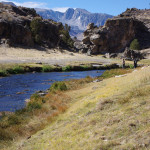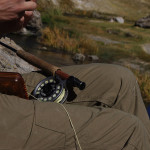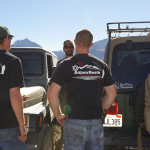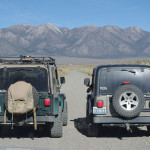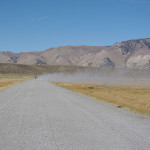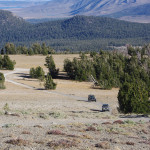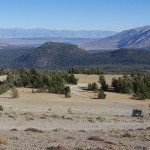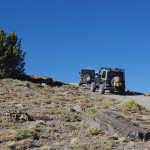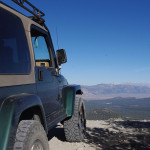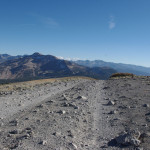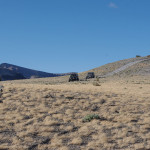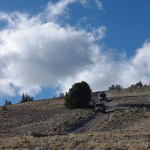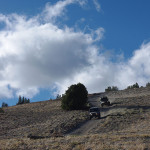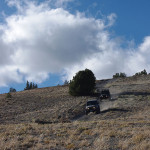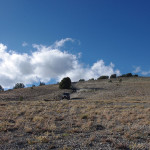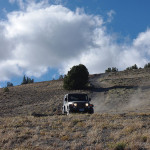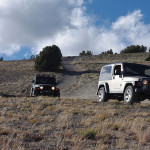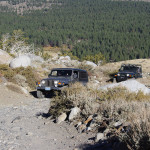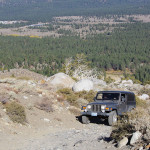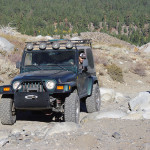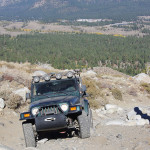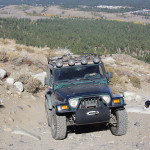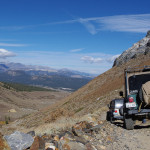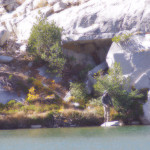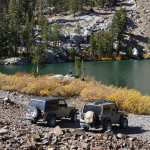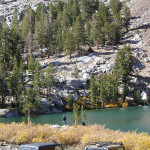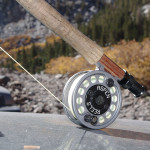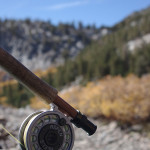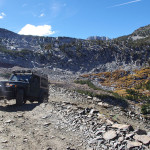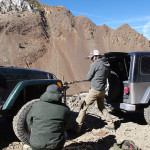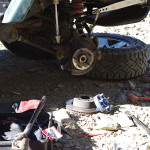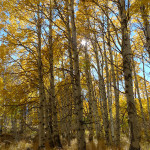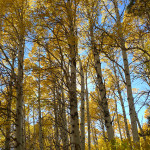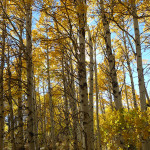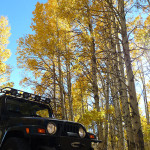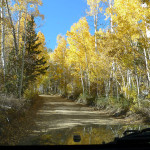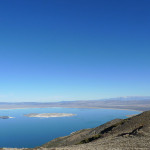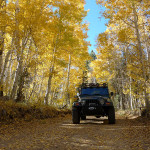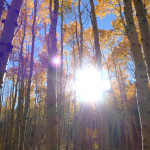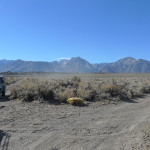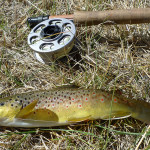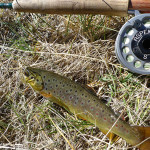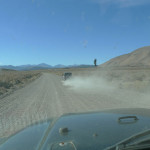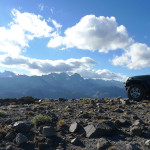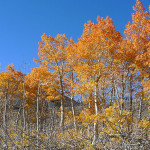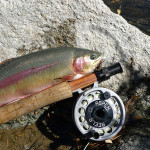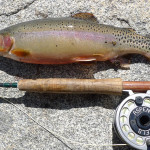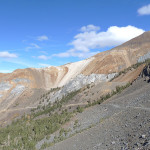This trip begins the way any great weekend begins: a dream of dirt under the tires or mended lines in the water find the need to become reality. Combining the two in an already compact time frame proves to be more difficult, but that is of little concern to those who call themselves Jeepers and fly fisherman. We do, after all, have the uncanny ability to tolerate washboard, find comfort in limited space vehicles and enjoy the entrapment of hobbies that require building, maintenance and a combined love of problem-solving in less than ideal conditions.
Friday morning was spent driving eastbound from the coast of California through Yosemite National Park after a toll for the quicker route. Every time I find myself on the 120 through Tioga Pass, I fail to stop within the park limits to fish. Initially, this would seem sacrilegious when you have a box full of flies and a pole ready in one of the most breathtaking glacial carvings in the world, but the bustle of doe-eyed tourists and the Mecca on the other side prevent me every time.
Seeking solitude, I took a detour at the end of the Tioga grade via Log Cabin Mine road. It’s a fairly easy trail using your transfer case to battle the high altitude climb, but the views at the end after a long drive are worth it. Parking at the peak just off of the return road gives you spectacular views South and East of the Mono Basin. If you have more time than I did, explore the old equipment at the nearby mine site.
I continued my push towards the town of Mammoth. First stop: the local fly shop. What’s hatching? How are the flows? How many people have come in here in the past 3 hours and asked you the same thing? Where did they say they were going? Do I have enough #22 Black Zebra Midges and WD40s? Probably not.
A call to the cohorts confirmed that I had time to hit one of the local creeks before dinner. I gassed up and took the Jeep out the dirt roads from Mammoth to the east side of Hot Creek. To mitigate brain rattle on the 30 minutes of washboard, I maintained speeds well above the assumed unposted limits. After I parked in an oddly empty dirt lot, I was surprised that I only shared the creek with three others. Flows were low, but the pockets were plenty. I headed straight to a proven spot. A #20 Pheasant tail followed by a #22 Black Zebra Midge hooked into the first brown of the trip only minutes into my initial casts.
Following that catch, my stubbornness kept me on a subsurface attack for the better part of 15 minutes while I watched top water rises. This lack of adaptation on my part resulted in no additional catches. The sun set behind Laurel Mountain and the rest of the Mammoth Crest peaks. With a headlamp on, the hike back up the ridge was spent reflecting on the journey out, coyote calls in distance, beautiful views and the catch of the day.
Pointing the Jeep south, I met my sister and her husband at the local watering hole – Tom’s Place. While we enjoyed your typical mountain town dive food, the search for a campsite took precedence, and we ate quickly. We found that all but one of the campgrounds in the area were closed to access by locked gate. It seemed that the USDA budget for Rangers in late season is the same as the IT staff keeping the website updated. Defeated, we made our way back to the more civilized camping arrangements. Following tent set up, fire building and the arrival of the final member of the trip (part extended family and part long time friend), the next rounds of beer were opened and the weekend plan was set in motion.
To clear the air, my extended family’s collection of International Scouts is one vehicle short of breaking single digits. For the sake of this trip, we’ll give them a break since they brought their LJ Rubicon, own the Aspen Fly Reel Company, and have proven themselves as a Pabst reserve when beer forecasts failed.
Morning broke and we found ourselves moving slow to pack up. An audible was called and the original plan for camp stove cooking was traded in for more mountain dive food. Heavily dosed with caffeine, greasy ham and eggs, we hit the long washboarded roads in an attempt to fish from the north side of the creek. This ridiculous goal, to put tens of miles of dirt under the tires to reach the other side of a ten foot wide creek, was made possible by the strict no wading policy. The detour didn’t bother us a bit.
We arrived north of the gorge for the first time and hiked down. Following suit to the day previous, a Pheasant Tail and Black Zebra Midge proved reliable by snagging three decent 10-12” browns and a slightly larger rainbow. Always looking to show the men in the family up; my sister caught the trophy brown of the day, which we could only estimate at a fat 18” since it missed the net and unhooked from the barbless #22 barrs flashback. Visual confirmation was enough for that fish. It was the largest any of us had seen on the creek. We took her glory by reminiscing for her while she remained focused on other things.
It was nearing early afternoon at this point; the bites slowed and we headed out for some trail time and views. Cutting right before Postpile Road and the ranger hut, we detoured up the San Joaquin ridge following a Jeep trail. The top had crystal clear views of the Ritter Range and Minarets, but also provided fifty mile per hour gusts of ice cold wind. Despite the setback, having the place to yourself is something else. Maybe next time this is where we should camp for the weekend. Taking our time at the top, acting like children – trying to see how far we could lean forward before our weight overcame the wind – we decided to head back down. Sometimes it’s just the simple things. That night we headed to the family cabin, made antelope burgers, watched westerns and planned our Sunday.
Fed and caffeinated, we left early to Laurel Lakes, a moderate 4×4 trail. Though a few in the group had wheeled the trail previously, we’ve never tried to fish the waters and certainly had no idea what to expect. With a 10 mile round trip before us and a deadline to hit the road home around 2:00PM, we all knew where this day was headed, but hit the trail nonetheless.
It took two hours to reach the top; climbing in low as the 242s gasped for air on the way to ten thousand feet and into the lake crater. After parking, we cracked a beer, loaded up our fishing gear and headed out to the water’s edge for a proper evaluation of the lake. We were greeted by frozen ground and brisk high thirties ambient temperature. Every other step broke ice and boots plummeted into a boggy, muddy mess as we moved west along the far edge. Fortunately, this hurdle was only located on the first hundred yards and we reached a location that provided hope of successful fishing. Winds were blowing right to left between three and five miles per hour with gusts up to thirty. It posed quite a challenge. Floating line, followed by sinking trout leader with 10 feet of 5x and two #16 Bead Head Pheasant Tail variations spaced 16 inches apart was my weapon of choice; though they weren’t the easiest to turn over in these conditions.
Three to four casts and fifteen minutes in, a hook was taken deep in the lake water. My cold fingers quickly manipulated line tension against the cork grip and I began taking up the stripping line. Following a minute or so of running, a truly beautiful golden appeared at the shoreline. With photos captured, the fish returned to fight another day.
Superstition followed the first catch and guided the duplication of the previously successful movement. During one of the strips, the line tightened, rod bent, then recoiled leaving the line limp in the water – a missed bite – then a dry spell. I hooked the fly onto the line guide and scrambled to a position on rocks a bit further around the lake that allowed the line to work with the wind. Comfortably casting, I let the line sink for a twenty count, then coerced the flies back by slowly stripping and twitching before throwing everything back out again. After a third cycle of this retrieval method, a heavy hit pulled line between my fingers to begin the best trout fight of the weekend.
After maneuvering the fish to shore, fumbling a camera and pole for a photo and then holding up the catch for the other members across the lake, the large golden swam back into the deep mountain lake. Thirty minutes followed by two more missed bites. We accepted defeat with dignity and hiked back to the truck. Though behind the originally scheduled departure, we navigated only a few more switchbacks before reaching the highest point of the trail. A single tight switchback was all that stood before the 2500 foot downhill descent. Easy.
Using the Jeep’s short wheelbase to set up on the outside of the road and cut the corner, the right front tire stuffed at full lock. POP. CLUNK. CLUNK. Great.
Jumping out of the jeep in a precarious position, the noise was inspected and easily diagnosed by a pile of metal shavings, needle bearings and other critical portions of the U-Joint resting on the bottom of the inner C. Fortunately, the mining road provided a good runway at the end of the switchback for a makeshift workshop.
Chock wheels. Break wheel nuts. Put spare under frame. Stabilize high lift. Lift vehicle. Pull wheel. Place under front bumper. Remove wheel spacer. 13mm 12 point. Remove brakes. Remove pin. Remove castle nut. Axle socket, ½” driver, high lift handle. Break axle nut. 13mm 12 point, ½” to ⅜” adapter, high lift handle. Break wheel bearing nuts. Remove wheel bearing. Pull axle shaft. Place rag in axle tube. Separate outer and inner. Place inner back into wheel bearing. Reinstall 13mm 12 point wheel bearing bolts. Torque by feel. Jam screwdriver into rotor. Axle Socket, ½” Driver, High lift handle. Tighten axle nut. Reinstall castle cap and pin. Reinstall wheel spacer. Torque by feel. Reinstall brakes. Reinstall wheel. Torque by feel. Tools packed up. Spare removed from under car and back on tailgate. ARB compressor on. Locker engaged. One hour delay. Back on road.
Note to Self #1: Preventatively maintain U-Joints.
Note to Self #2: Always bring your tools; chances are you have neglected the prior step.
Note to Self #3: The complete set of spare shafts at home in your garage do you no good out here.
Note to Self #4: The spare U-Joint in your tool box only helps your driveshaft. Pack another that fits your axle shafts.
Though easy on the car, the drive down the switchback grade felt restless with “What’s next?” echoing in the back of my brain.
Pavement. Inspection. Systems somewhat operational. Will it last 272 miles back home?
Mexican food. Tires are returned to highway pressures. Gas. Dark clouds over the mountains. Three hours after the original departure time. Weather station on the HAM reported:
“Winter Weather Advisory for the Eastern Sierras over Mono and Tioga pass. Winds gusts up to…”
There are better things to listen to than the drone, lifeless voice of the NOAA telling you that this could become an even worse idea before heading to 9,943 feet and winding through Yosemite. But knowledge is power, so I endured the warning monotony until the voice disappeared to white noise and the squetch took over. A few quick flurries of dusted snow hit going through the park, but nothing a single swipe of the wipers couldn’t fix. Concerned with other damage that could’ve occurred on the mountain, the drive back was long as the Jeep was consistently passed by semis. The slow drive home provided a lot of reflection time.
The paths that bring one to fly fishing and to Jeep ownership isn’t all that different. For me; in late childhood, I arrived at a stage where dropping lines in bodies of water wasn’t gratifying anymore. Enter – my first fly pole. I had no idea what I was doing, but knew that if I focused on the combination of skill sets, results could be yielded. During those times on the water, I could sit and adjust, learn the water, learn what was in the water and how to fish it. That was well over a decade ago and to this day, I’m much better at going fishing than catching. Similarly with cars, I’m much better at wrenching than driving. The entry into Jeeps came when I realized my vehicles couldn’t take me to the places that I enjoyed being. Modifying cars that only pushed asphalt… well, they were exactly that – a means of urban transportation. So I moved on. Enter – the TJ.
First experiences and recent experiences, this one included, can be filled with wrong line choices and leaving critical parts at home. The following weekends will be filled with fixing problems the previous weekends created. Each time on the trail, you evaluate the path, speculate the clean way of maneuvering then attempt to drive it.
We call these challenges fun.
When it comes down to it, the balance of time spent fishing vs catching or wrenching vs driving doesn’t matter. Getting out with a Jeep and a fly pole; the escape, the experience, the enjoyment, is why we own them.
I’ll be waiting a very long time for that balance to tip – to transition to catching and driving; but I can assure you, I won’t regret a single moment in the garage or a fishless day chasing that change. Some lifelong hobbies are meant for eachother. Jeeping and fly fishing are among them.



